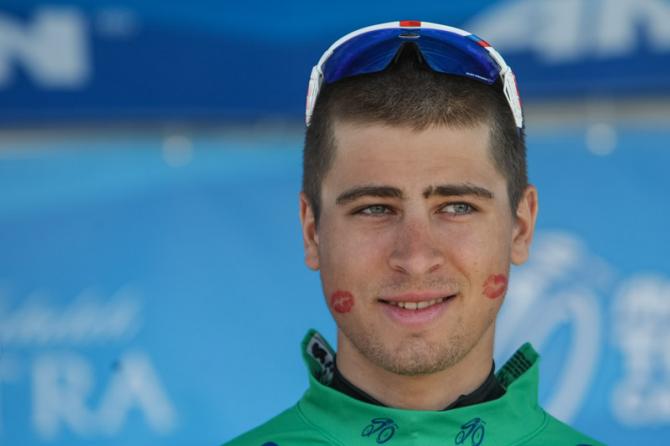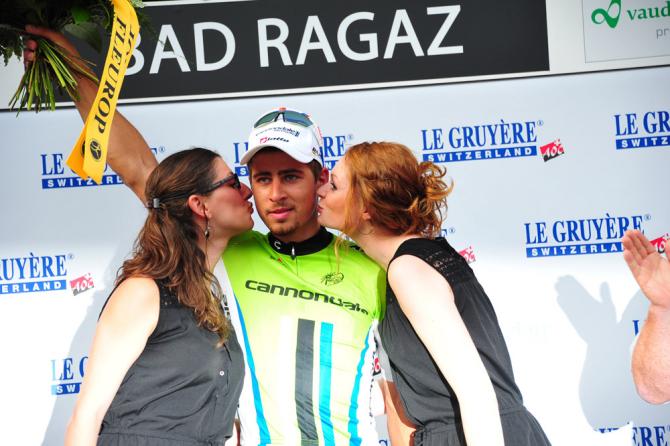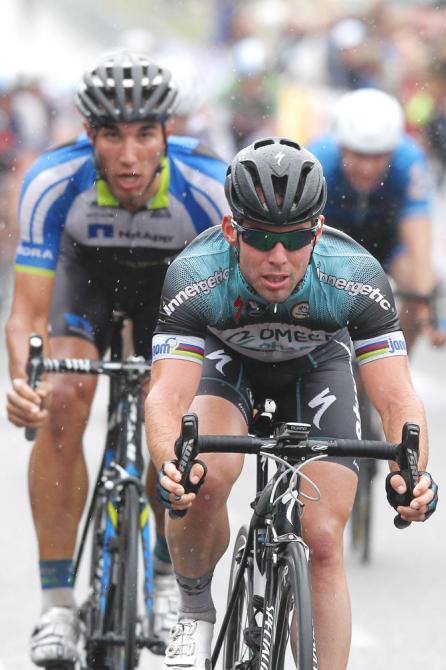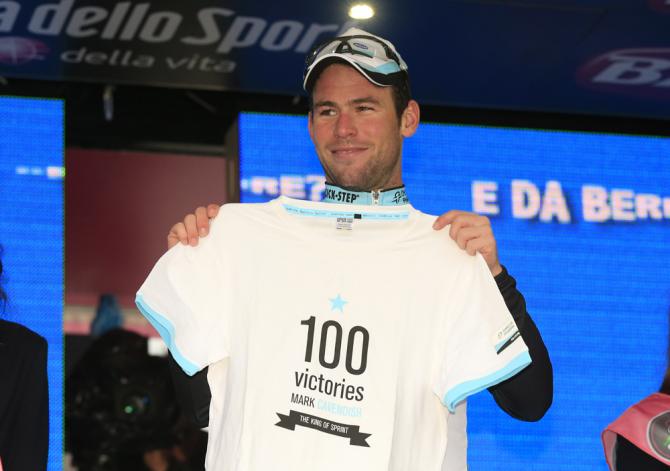Tour de France 2013: Sagan, Cavendish and the fight for the green jersey
Breaking down the points competition




When ASO altered the scoring system for the points competition ahead of the 2011 Tour de France, it appeared to mark a discernible shift in the philosophy behind the green jersey. Rather than ostensibly rewarding consistency over all terrains, the structure now seemed weighted very explicitly in favour of the pure sprinters, with the points for a flat stage win increased to 45 and with one “super” intermediate sprint worth 20 points replacing the traditional brace of sprints worth six points apiece.
In particular, one senses that the organisers wished to correct a glaring anomaly, namely that Mark Cavendish had never succeeded in carrying the green jersey to Paris in spite of averaging a prodigious five stage wins in each of the previous three Tours.
Cavendish, as is his wont, duly won his quota of five stages at the 2011 Tour, and the new points system meant that he could even afford to lose points for finishing outside the time limit and still claim the green jersey with plenty of breathing room. Then only 25 and showing no signs of slowing down, it seemed as if the Manxman had the points competition sewn up for the foreseeable future.
And then, in 2012, Peter Sagan arrived for his debut Tour and the dynamic of the points competition was blown open all over again. Sagan seemed an Anton Chigurh-like figure, devastating the competition as the pure sprinters came up against a phenomenon that they couldn’t quite understand.
Sagan’s haul of three stage wins was matched by both Cavendish and André Greipel, but such was his ability to pick up points on all terrains – in bunch sprints and even in the high mountains – that the Slovak had all but sealed the green jersey by the second rest day and reached Paris with a winning margin of some 141 points.
Not since Sean Kelly in the 1980s has the maillot vert been won by a rider regularly capable of scoring so many points in so many different situations, and long before Sagan reached Paris, speculation was building as to whether he could rival or even beat Erik Zabel’s record of six green jerseys.
One can never step into the same river twice, however, and while the bookmakers have understandably installed Sagan as the favourite to repeat his victory this year, Cavendish finds himself in very different circumstances to twelve months ago. The battle for the green jersey promises to be a tight one, and Cyclingnews takes a look at some of the factors that will decide the outcome.
Get The Leadout Newsletter
The latest race content, interviews, features, reviews and expert buying guides, direct to your inbox!
The route
Eight stages on this year’s parcours have been classified by ASO as flat, with a full complement of 45 points on offer for the winner. A further three stages are described as “parcours accidenté,” with 30 points for the winner, while there are 20 points for the victors in the mountains and individual time trials.
Thus, there are, in theory, at least eleven stage finishes where Cavendish, Sagan or both could be in the mix for victory. A cursory glance at the road book identifies at least six flat finales where, all things being equal, Cavendish will be favoured to contest – and indeed win – the sprint finish: stage 1 to Bastia, stage 6 to Montpellier, stage 10 to Saint Malo, stage 12 to Tours, stage 13 to Saint-Armand-Montrond and the final stage on the Champs-Élysées.
Sagan, meanwhile, will doubtless look to the rugged stages 2 and 3 in Corsica as early opportunities to win a stage, even if there are only 30 points on offer for the stage winner rather than 45. Similarly, on the evidence of Tirreno-Adriatico and the Tour de Suisse, Sagan could perhaps also stretch himself to score more points on an additional stage – on the road to Gap on stage 16, where Cavendish will again not be in the mix.
Assuming that Sagan places consistently wherever Cavendish wins, a trio of “swing states” as it were, could prove crucial to the green jersey campaign: namely stage 5 to Marseille, stage 7 to Albi and stage 14 to Lyon. Each stage includes enough rolling terrain to encourage a break or perhaps to split the peloton in the closing kilometres, and Sagan will certainly be hoping that Cavendish can be distanced on at least one of these finales. However, if Cavendish climbs as well as he did on the Cipressa at Milan-San Remo in March, for instance, Cannondale could have their work cut out to shed Sagan of his rival.
That said, Sagan padded out his points tally last year by infiltrating breaks in the high mountains, most notably on the road to Foix in the Pyrenees, when he finished second on the stage. The increased number of summit finishes on this year’s route means that opportunities for Sagan to do something similar in 2013 are more limited. However, he is more than capable of picking up 20 points at an intermediate sprint on any given day over the three weeks, and that could make all the difference come Paris.
Team support
Twelve months ago, Cavendish was very much an afterthought on a Sky team dedicated to the overall challenge of Bradley Wiggins, even if prior to the race, the official line was that the squad was aiming to carry both yellow and green jerseys to Paris. After four Tours with the Highroad train devoted solely to him, Cavendish had to feed off a more restricted diet of opportunities last year, but still came away with three stage wins, even if he was never a factor in the points competition.
A year on, the situation couldn’t be any more different, as Cavendish lines up as the sole leader of a strong Omega Pharma-QuickStep outfit that has begun to click after some teething problems with its sprint train earlier in the year. Ahead of them Giro d’Italia, Gert Steegmans took over from Matteo Trentin as Cavendish’s last man and that combination proved a successful one as the Manxman claimed five wins from five sprints in Italy. Adding firepower to the lead-out at the Tour will be world time trial champion Tony Martin, as Rolf Aldag explains: “Tony will be there to ride to the 'Flamme Rouge' on the flat stages. He will bring Matteo, Gert and Cav into the best position possible in the final kilometre.”
Sagan, too, has the undivided attention of his Cannondale squad this year after sharing top billing with Vincenzo Nibali in 2012. In the flat stages, Sagan will be able to rely on the lead-out of Fabio Sabatini, while in the more rugged finales, he could form a redoubtable double act with Tour debutant Moreno Moser.
Beyond that, Sagan recognises that beating Cavendish to the green jersey will require him to score points on stages where the Manxman does not, and this is where the likes of Alessandro De Marchi will earn their keep. “The team will also include riders who can help me on the climbs. Most sprinters will be dropped on the climbs but with the help of my teammates I hope to stay at the front,” Sagan told a press conference in Bratislava on Monday.
Form
Since 2010, Cavendish’s seasons had been built around specific “projects,” namely the world championships and the Olympics Games, but he has perhaps been able to race with a little more freedom this year. Rather than building diligently towards some far-off goal, Cavendish has simply been able to chase victories as and when he could find them in 2013, and as a result he has enjoyed his most consistent early season since 2009.
Cavendish’s good condition was not rewarded with the results he would have liked in the Classics, but he compensated for that with a fine showing at the Giro d’Italia, where he was a deserved winner of the red jersey, completing a full set of Grand Tour points competitions. The cancellation of the Stelvio stage helped to fend off Nibali’s challenge but Cavendish had more than earned that stroke of fortune. Unlike the Tour, the Giro’s points system makes no concessions to the sprinters and in order to win, Cavendish had to hold up his end of the bargain by winning all five of the bunch sprints he contested in Italy.
Like Cavendish, Sagan has also won twelve races so far in 2013, including a rare sprint win ahead of the Manxman at Tirreno-Adriatico. Sagan’s versatility is what stands out, however, given that his second stage win at Tirreno came ahead of Nibali and Joaquim Rodriguez in the race-deciding break on the tough stage to Porto Sant’Elpidio. The Slovak 23-year-old also claimed a maiden classic victory at Gent-Wevelgem, a stirring Brabantse Pijl win ahead of Philippe Gilbert and a brace of monument runner-up places at Milan-San Remo and the Tour of Flanders.
After a post-classics break, Sagan returned to winning ways with a brace of stage wins at the Tour of California and the Tour de Suisse. In Switzerland, in particular, his climbing form was in evidence, as he took victory on two rugged stages although he struggled with his positioning in the pure sprint finishes.
Cavendish, meanwhile, marked his return to racing after the Giro by finishing third overall at the Ster ZLM Toer. Like in 2012, he didn’t win a stage in the Netherlands but, for once, the aim was to build condition ahead of the Tour rather than necessarily bag another victory, and the Manxman will head to France in confident mood.
Greipel, Kittel, Goss and company
Understandably, but perhaps unfairly, all eyes are on Cavendish and Sagan in the battle for the green jersey, but one should overlook the sheer depth of the sprinting field in this year’s Tour de France. Perhaps not since the 1990s has there been a Tour with so many high-calibre fast men in action simultaneously, with André Greipel (Lotto Belisol), Matt Goss (Orica-GreenEdge), Marcel Kittel (Argos-Shimano) and John Degenkolb (Argos-Shimano) joining Sagan and Cavendish in the frenetic bunch finishes of the opening week.
Greipel won three stages last year, Degenkolb claimed the points competition at the Vuelta a España in emphatic fashion last year and Goss has the ability to get over climbs like few other fast men, and so all three will line up at the Tour harbouring ambitions of getting involved in the fight for the green jersey.
At the very least, Greipel, Goss, Degenkolb and Kittel have the ability to win stages and to take points away from both Cavendish and Sagan, while Lotto Belisol, Orica-GreenEdge and Argos-Shimano all have sprint trains capable of competing with Omega Pharma-QuickStep in the finale. Sagan and Cavendish might be the leading candidates for the maillot vert, but they are not competing in a vacuum, something which only adds to the tactical intrigue of the contest.

Barry Ryan was Head of Features at Cyclingnews. He has covered professional cycling since 2010, reporting from the Tour de France, Giro d’Italia and events from Argentina to Japan. His writing has appeared in The Independent, Procycling and Cycling Plus. He is the author of The Ascent: Sean Kelly, Stephen Roche and the Rise of Irish Cycling’s Golden Generation, published by Gill Books.